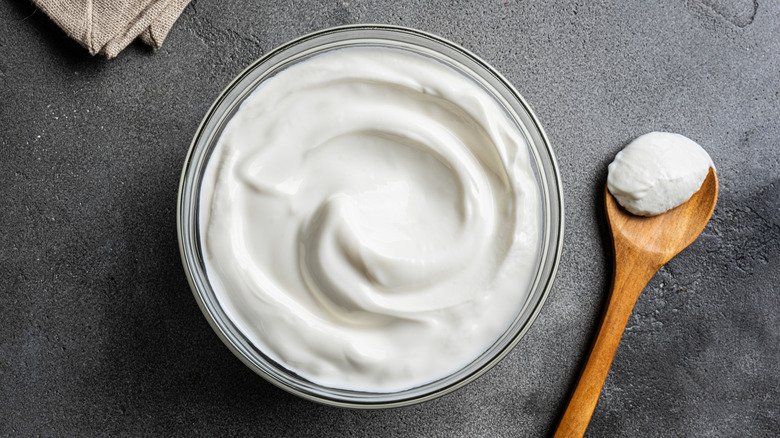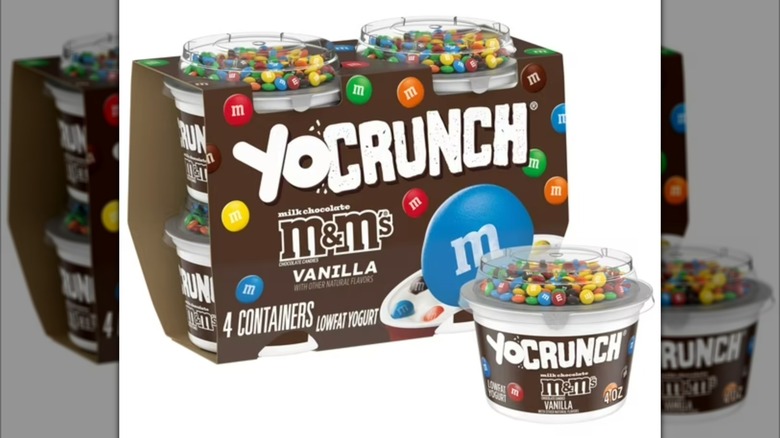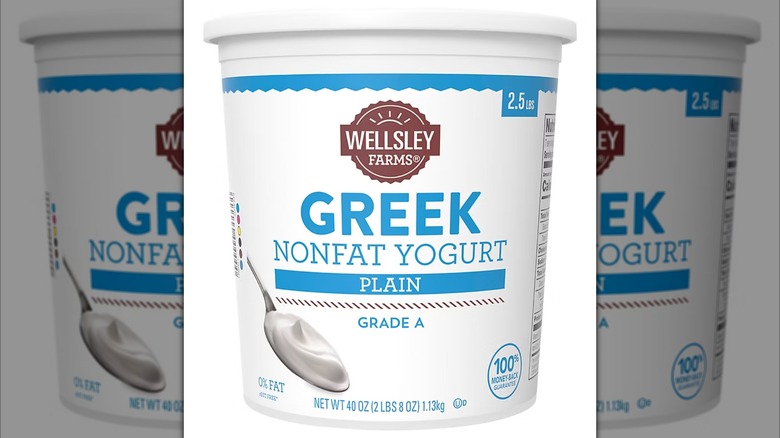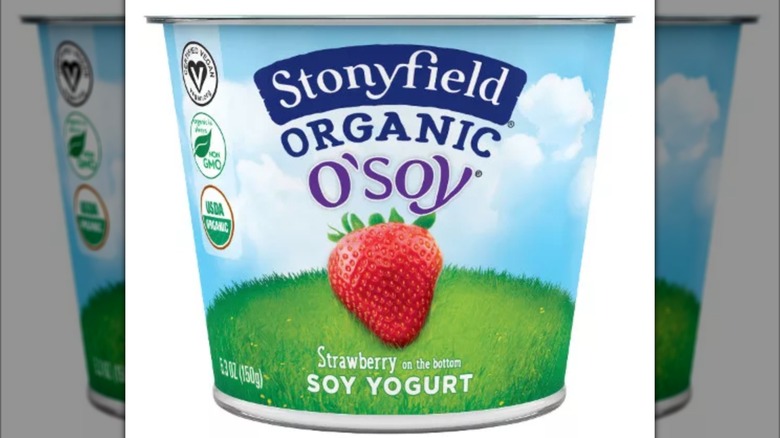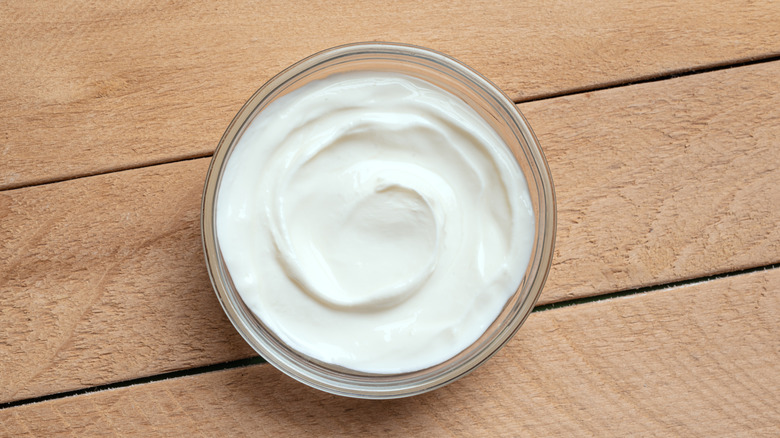10 Of The Worst Yogurt Recalls In History
We don't know if you know this, but yogurt is pretty popular. This dairy product has been eaten by humans for over 7,000 years, and today it's enjoyed in countless different forms: Frozen yogurt for a delicious treat, as a coating for your favorite confectionery, as a base for a timeless dessert topped with berries and granola, as a savory dip, and on its own. In the United States, over 5% of adults and 6% of children eat yogurt regularly, adding up to millions of people and a lot of products to feed them. Yogurt is usually considered a healthy part of your diet, but unfortunately, the sheer amount of yogurt out there in all of its shapes and sizes means that there's a lot of scope for things to go wrong, and when they do, they can be pretty bad.
Yogurt recalls have historically been pretty massive affairs, affecting hordes of people and involving thousands of pounds of product at a time. Additionally, yogurt is one of those foods that seems to get contaminated in loads of different ways. Over the years, yogurt recalls have been issued due to plastic, bacterial contamination, pesticides, and even cyanide getting into it. We know, we were shocked too. If you think that yogurt is a harmless dessert, prepare to have your world rocked by these historic recalls.
1. Plastic contamination was the cause of a 2025 YoCrunch recall
Plastic getting into food is a depressingly common occurrence, and given that every tub of yogurt out there is made of plastic itself, it's probably no surprise that this is a food where it happens a lot. In 2025, plastic contamination struck yet again, this time affecting Danone U.S. and its YoCrunch yogurts, which is already a fairly unhealthy yogurt brand. 17 individual products had to be recalled by the company, with its yogurts having to be tracked down across the entire country. It wasn't just isolated lots that were affected, either: Dozens of lots for each individual flavor were potentially impacted, adding up to a huge amount of product.
The plastic pieces found in the yogurts were reportedly found in the plastic topper, where the crunchy portion of the product is found. These weren't small pieces of plastic, either — some were said to measure up to 25 millimeters in length. This represents a significant choking hazard, particularly because these yogurts are intended for kids. It was made even riskier by the way that people generally eat these sweet treats, by tipping the entire topper into the yogurt and stirring, thereby allowing any plastic to get lost in the yogurt itself. As of late July 2025, the recall was still ongoing.
2. A Rizo-Lopez Foods recall in 2024 was issued due to Listeria
Along with E. coli, Listeria monocytogenes is a type of bacteria that's responsible for a huge amount of food recalls, from packaged walnuts to supermarket broccoli florets. This bacteria can get into virtually any food, and when it does, things can quickly spiral out of control. Contamination like this can lead to illnesses and, in the worst-case scenario, deaths. This was sadly the case in 2024, when an outbreak of Listeriosis was traced back to dairy products made by Rizo-Lopez Foods. Listeriosis cases began to be recorded at the end of 2023, and a few months later, the company recalled its entire product line, including yogurt, cheese, and sour cream, after it was discovered that they could be the cause. In April 2024, the outbreak was eventually traced back to Rizo-Lopez Foods' queso fresco and cotija cheese, but by that point, all of its items were off the shelves.
Unfortunately, the recall came too late to avoid some grave outcomes. 26 people across 11 states became ill from eating the company's products, and 23 hospitalizations occurred as a result. The Listeriosis outbreak also resulted in two deaths, and one person experienced a pregnancy loss as a result of their illness. The company was subsequently subject to court actio,n which prohibited it from producing food until further notice.
3. A 2015 recall was issued following Listeriosis illnesses and deaths
Frozen yogurt usually seems pretty uncontroversial, right? Sure, it can be a little high in sugar sometimes, and some brands can be as unhealthy as ice cream, but in general, it's viewed as fairly nutritious. Back in 2015, though, froyo took on a decidedly more nasty edge when it was discovered to be the potential source of a terrifying Listeriosis outbreak. 10 people across Texas, Arizona, Oklahoma, and Kansas were hospitalized with a serious case of the illness. Three people, all from Kansas, sadly died as a result of their infection.
The investigation into the outbreak conducted by the Centers for Disease Control and Prevention (CDC) eventually linked it to Blue Bell Creameries, a dairy producer that had issued a major recall of its products in April of that year. Its ice cream, sherbet, and frozen yogurt were all taken off shelves. It's a good thing, too, as Listeria was eventually found in three of its facilities, with its Texas and Oklahoma facilities acting as the source of contamination in various products. Its Alabama facility was also implicated, but no products from this factory ended up causing infection. In subsequent investigations by the U.S. Food and Drug Administration (FDA), it was found that its Texas factory was operating under unsatisfactory conditions and failed to perform adequate bacterial testing.
4. When plastic was found in Wellsley Farms yogurt, a recall ensued
You know what we don't want when we take a big spoonful of creamy yogurt? A big hunk of plastic inside it. This doesn't feel like an unreasonable ask, but the memo apparently didn't reach Wellsley Farms in 2015, which had to issue a recall of a huge quantity of its yogurt. The food company's plain and vanilla non-fat Greek yogurt flavors, which had been shipped to three different states, were affected by plastic contamination. In total, almost 16,000 cases (that's cases, not pots, folks) of each flavor had to be tracked down. Because the yogurt was being sold in 40-oz tubs, this equated to tons of product.
The FDA marked this event as a Class II recall, indicating that while ingesting the yogurt may not have caused serious long-term health consequences, it could have prompted nasty short-term issues. Regardless, it's a good thing that Wellsley Farms acted when it did. Plastic contamination isn't just a choking hazard — it can also cause cuts and abrasions to mouths and digestive tracts, as well as causing gastrointestinal issues and plastic absorption into the bloodstream.
5. An entire line of soy yogurt was recalled because it potentially contained milk
Soy yogurt may feel like it's only been around for a few decades, but it started appearing in various forms in the United States at the start of the 20th century, before becoming more established in the 1970s and 80s. With all of that time for food companies to develop their recipes and formulations, it's surprising that things can still go wrong. They did, however, in 2017, when production of Stonyfield's O'Soy yogurt took a nosedive in a big way — the company shipped and sold containers of its product which apparently had regular dairy yogurt inside. Yikes.
Naturally, this was an enormous issue for Stonyfield. A large proportion of people who eat soy yogurt do so because of an aversion to dairy, either because of an intolerance or an allergy, with the latter potentially producing grave symptoms if dairy food is ingested. It seems like sheer luck that nobody became sick from eating the yogurt, although Stonyfield was alerted to the mislabeling issue by two customer complaints. These complaints prompted a large recall of the yogurt product across 18 individual states.
6. A 1982 recall involved pesticides
You know what we really don't love? When food products are contaminated with pesticides. Call us old-fashioned, but it doesn't exactly thrill us to know that the items we're eating could be poisoning us. Sadly, back in 1982, that could have been the case for people living on Oahu, Hawaii. A slew of recalls across the island of dairy products, including yogurt, were issued when it was found that they contained elevated levels of heptachlor, a pesticide sprayed on pineapple leaves that served as feed for dairy cows. Alongside the yogurt, ice cream, milk, buttermilk, and cottage cheese products were recalled.
If you haven't heard of heptachlor, there's a good reason for that. A few years after this recall incident, the sale and the majority of uses of heptachlor were prohibited, amidst evidence that it was a carcinogen. It has also been associated with a range of short- and long-term effects, including neurological damage, harm to organs, and gastrointestinal issues. A study of the long-term effects of the heptachlor contamination incident on children born on Oahu found that it didn't result in higher rates of cancer or mortality, but it was certainly a scary time for the communities living there.
7. Pure Eire Dairy's recall of its yogurt led to its permanent closure
Every now and again, a recall incident comes along that's so disastrous that it leads to the complete downfall of a company. That happened in 2021, following a multi-county outbreak of E. coli that resulted in 17 individual cases of sickness as a result of eating contaminated yogurt. Pure Eire Dairy, a yogurt producer operating in Washington state, was found culpable after its organic pasteurized yogurt products were linked to the outbreak. Although it issued a recall of its yogurts, it wasn't quick enough to prevent 10 people from being hospitalized as a result of illness.
Things were made even worse by the fact that more than half of the individuals who became sick from eating its yogurt were children. Furthermore, four of the people hospitalized with E. coli sickness went on to develop hemolytic uremic syndrome, or HUS, a potentially deadly form of kidney failure. While nobody died from eating the yogurt, that wasn't enough to keep Pure Eire Dairy from facing the worst consequences possible. The company faced extensive litigation from the victims, and shut its doors for good.
8. Frozen yogurt was the subject of a 2025 recall
Store-bought frozen yogurt is sold by the bucketload during the spring and summer months, with dairy producers knowing that the warmer weather ushers in people's desire for cold, sweet treats. However, the more froyo being sold, the more likely it is that things will go wrong in a big way. That was the case in April 2025, when a recall was initiated by Wells Enterprises, Inc. for its frozen yogurt and ice cream products, following fears that they could be contaminated with plastic. Wells Enterprises naturally had to track down its items and try and get them off shelves before it was too late.
The problem was that it had an absolutely enormous amount of products to locate. Its frozen yogurt and ice cream, which were sold in 3-gallon tubs in multiple different flavors, had been sent to 103 distribution centers across the entire country. Thousands upon thousands of tubs were affected, and in total, over 16,000 gallons of product had to be identified and disposed of. This recall no doubt cost Wells Enterprises a huge amount of money, and although nobody became ill or injured from eating its dairy items, its reputation also took a big hit.
9. In 1989, yogurt contaminated with cyanide prompted a huge recall
Okay, so we can understand how some things, like plastic pieces, unwittingly make it into yogurt products. However, it's way more unusual and upsetting when a substance as deadly as cyanide ends up in food items like yogurt. Nonetheless, in 1989, that exact thing happened. Breyers dairy products had to be pulled from supermarkets across several different states after a teenager became critically ill upon eating a container of cherry yogurt. In total, Breyers yogurt in 166 individual stores had to be recalled.
Investigators found that the yogurt pot, which came in a multipack, contained a large concentration of cyanide. The victim, Thomas Lee, tragically died after falling into a coma as a result of the poisoning. The investigators in the case initially believed that this incident could be due to product tampering, and may have been linked to another cyanide poisoning case several years before. However, it was later concluded by the medical examiner that Lee had died by suicide.
If you or someone you know is struggling or in crisis, help is available. Call or text 988 or chat 988lifeline.org
10. Three months' worth of frozen yogurt had to be recalled in 2012
Sometimes, one recall can knock out months' worth of stock for companies. That very situation occurred in 2012 when the Berkey Creamery, a producer operating out of the Penn State University campus, had to initiate a recall for its frozen yogurt and ice cream products. The recall was issued after the creamery caught wind of people finding small pieces of plastic in their desserts.
Unfortunately, the extent of the risk involved meant that Berkey Creamery had to recall products made over a period of three months, from May 16 to August 11. The creamery might have gotten away with this being a relatively small issue, given that its products were primarily sold across Indiana. However, the online availability of its frozen yogurt and ice cream meant that this spiraled into a much larger recall, which was made even bigger by the company opting to track down all of its container sizes, instead of just the half-gallon tubs, which were found to be contaminated.
